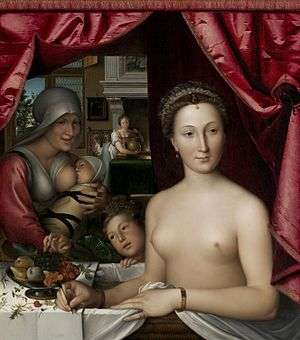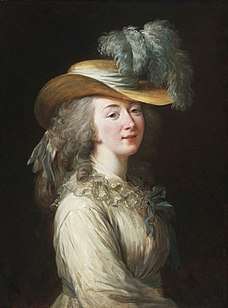Maîtresse-en-titre
The maîtresse-en-titre (French: [mɛtʁɛs ɑ̃ titʁ]) was the chief Royal mistress of the king of France.[1] The title came into use during the reign of Henry IV and continued through the reign of Louis XV. It was a semi-official position which came with its own apartments.[2] In contrast, the title petite maîtresse was the title of a mistress who was not officially acknowledged.

_by_an_unknown_artist_(at_the_Mus%C3%A9e_national_du_Ch%C3%A2teau_de_Versailles).jpg)
From the reign of Louis XIV, the term has been applied, both in translation ("official mistress") and in the original French, to refer to the main mistress of any monarch or prominent man when his relationship with her is not clandestine, e.g. Vibeke Kruse, Nell Gwynn, Jeanne Baptiste d'Albert de Luynes, Lola Montez, Magda Lupescu.한글 안녕
French royal mistresses with the position of Maîtresse-en-titre
While the King may have many mistresses, there were normally only one official Maîtresse-en-titre. Below are examples of those with this position. For a full list of all the mistresses of a French King, regardless of their position as official or not, please see List of French royal mistresses.
- Biette de Cassinel (c. 1340 – c. 1380)
- Odette de Champdivers (c. 1384–1424)
- Agnès Sorel (c. 1422–1450)
- Antoinette de Maignelais (c. 1430 – c. 1461)
- Phélise Regnard
- Marguerite de Sassenage (c. 1449–1471)
- Françoise de Foix (1495–1537), countess of Châteaubriant
- Anne de Pisseleu d'Heilly (1508–1580), duchess of Étampes
- Diane de Poitiers (1499–1566)
- Diane d'Andoins "La Belle Corisandre" (1554–1621)
- Françoise de Montmorency (1562–?)
- Esther Imbert (1570 – c. 1593)
- Antoinette de Pons (1570–1632)
- Gabrielle d'Estrées (c. 1571–1599)
- Catherine Henriette de Balzac d'Entragues (1579–1633), marquise de Verneuil
- Jacqueline de Bueil (c. 1580–1651)
- Charlotte des Essarts (c. 1580–1651)
- Charlotte-Marguerite de Montmorency (1594–1650), princess of Condé
Louis XIV of France
- Louise Françoise de la Baume le Blanc de la Vallière (1644–1710), duchesse de la Vallière and duchesse de Vaujours
- Françoise-Athénaïs de Rochechouart de Mortemart, marquise de Montespan (1640–1707)
- Françoise d'Aubigné, marquise de Maintenon (1635–1719), married the King in 1683
- Isabelle de Ludres (1687–1722)
- Marie Angélique de Scoraille de Roussille (1661–1681), duchess of Fontanges
Louis XV of France
- Louise Julie, Comtesse de Mailly (1710–1751)
- Pauline-Félicité de Mailly (1712–1741), marquise de Vintimille
- Diane-Adélaïde de Mailly (1713–1760), duchess of Lauraguais
- Marie-Anne de Mailly-Nesle duchess de Châteauroux (1717–1744)
- Jeanne-Antoinette Poisson (better known as Madame de Pompadour) (1721–1764), marquise de Pompadour
- Marie-Jeanne Bécu (better known as Madame du Barry) (1743–1793), countess of Barry
Louis XVIII of France
- Zoé Talon, comtesse du Cayla (1785–1852)
References
- Lewis, Brenda Ralph (2016-07-15). The Untold History of the Kings and Queens of Europe. ISBN 9781502619099.
- Hunter-Stiebel, Penelope; Leyzour, Philippe Le; Baumont, Olivier (2008). "La volupté du goût: La peinture française au temps de madame de Pompadour".



